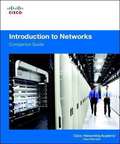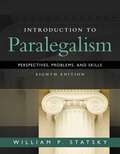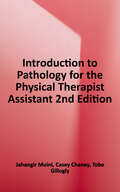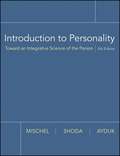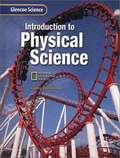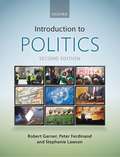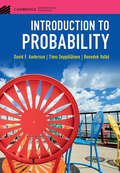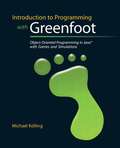- Table View
- List View
Introduction to Medical-Surgical Nursing (Fifth Edition)
by Adrianne Dill LintonWith just the right level of information to equip you to effectively care for adults and older adults, Linton''s Introduction to Medical-Surgical Nursing, 5th Edition is the leading LPN/LVN text in its field. Covering both med-surg and psychiatric mental health conditions and disorders, it addresses your role in a variety of care settings, emphasizes culturally competent care and holistic nursing, and thoroughly covers all relevant NCLEX-PN Test Plan content. Abundant real-life case studies clearly show how to apply what you''ve learned to clinical practice. Features separate chapters on common, high-profile disorders (including hypertension, diabetes, and shock), providing an in-depth understanding for patient care. Offers foundational units on basic concepts related to the health care system, care settings, the nursing process, leadership, nutrition, the older adult, growth and nutrition, legal/ethical considerations, evidence-based nursing care, and many more essential topics, avoiding repetition later in the text Includes a separate, comprehensive unit on the older adult and related disorders - no other LPN/LVN med-surg text has as much coverage of this primary patient group. Includes a separate, comprehensive unit on psychosocial responses to illness, psychiatric disorders, and substance abuse - eliminating the need for a separate psychiatric mental health nursing text. Emphasizes content related to the NCLEX-PN Test Plan, including health promotion, nutrition, legal/ethical issues, HIPAA, and prevention of medication/medical errors. Offers in-depth pharmacology coverage: the Pharmacology Tutorial covers drug classifications, how drugs work, and nursing responsibilities; Pharmacology Capsules boxes provide medication information, precautions for use, interactions, and side/adverse effects; and Pharmacology and Medications tables in body systems chapters include classification, use/action, side/adverse effects, and nursing interventions - all with the goal of reducing medication errors on the job and equipping you to pass the NCLEX exam. Assists with assignment and supervision, helping you assign tasks to nurse assistants, patient care techs, and unlicensed assistive personnel, and making sure you understand the difference between delegation, management, supervision, and assignment of tasks on the health care team. Features Diagnostic Tests and Procedures tables for a quick reference to MRI, CT, Doppler flow, lumbar puncture tests for neurologic disorders, and much more. Highlights timely information with Health Promotion boxes, Cultural Considerations boxes, Nutrition Considerations boxes, and Complementary and Alternative Therapies boxes. Provides bulleted lists of nursing instructions for Patient Teaching Plans, stressing the role and responsibility of the LPN/LVN to reinforce patient education. Provides consistent Nursing Care Plans that reinforce the nursing process and focus on critical thinking, and Put on Your Thinking Cap Critical Thinking boxes encourage you to pause and consider the practical implications of what you have just read. Highlights safety and risk factors with a new Safety Considerations icon, alerting you to potential risks in the clinical setting. Emphasizes evidence-based practice, providing specific examples of how scientific evidence can justify and support patient care. Offers a unique focus on prioritization throughout, with top priorities for each major disorder emphasized in all nursing care sections, to help you better prepare for the NCLEX exam. Get Ready for the NCLEX-PN Examination! includes Key Points, Review Questions, and Case Studies that address the NCLEX Client Needs categories of Safe and Effective Care Environment, Physiological Integrity, Psychosocial Integrity, and Health Promotion and Maintenance. An excellent review for course assessments and the NCLEX exam!
Introduction to Mythology: Contemporary Approaches to Classical and World Myths
by Eva M. Thury Margaret K. DevinneyIntegrating original texts with explanations, interpretations, and theory, Introduction to Mythology: Contemporary Approaches to Classical and World Myths, Fourth Edition, introduces students to a wide range of myths drawn from sources all around the world and approached from various critical perspectives.
Introduction to Mythology: Contemporary Approaches to Classical and World Myths (3rd Edition)
by Eva M. Thury Margaret K. DevinneyIntegrating original texts with explanations, interpretations, and theory, Introduction to Mythology: Contemporary Approaches to Classical and World Myths, Third Edition, introduces students to a wide range of myths drawn from sources all around the world and approached from various critical perspectives. The third edition strengthens its global coverage with two new chapters: Chapter 11, "Mesoamerica: Popol Vuh," and Chapter 43, "The Vampire as Hero: Tales of the Undead in a Contemporary Context."
Introduction to Networks Companion Guide [Cisco Networking Academy Series]
by Cisco Networking AcademyIntroduction to Networks Companion Guide is the official supplemental textbook for the Introduction to Networks course in the Cisco® Networking Academy® CCNA® Routing and Switching curriculum. The course introduces the architecture, structure, functions, components, and models of the Internet and computer networks.
Introduction to Networks Course Booklet (CCNA)
by Cisco Networking AcademyYour Cisco Networking Academy® Course Booklet is designed as a study resource you can easily read, highlight, and review on the go, wherever the Internet is not available or practical: The text is extracted directly, word-for-word, from the online course so you can highlight important points and take notes in the “Your Chapter Notes” section. Headings with the exact page correlations provide a quick reference to the online course for your classroom discussions and exam preparation. An icon system directs you to the online curriculum to take full advantage of the images embedded within the Networking Academy online course interface and reminds you to do the labs, interactive activities, packet tracer activities, watch videos, and take the chapter quizzes. <p><p> The Course Booklet is a basic, economical paper-based resource to help you succeed with the Cisco Networking Academy online course. <p><p> This book is offered exclusively for students enrolled in Cisco Networking Academy courses. It is not designed for independent study or professional certification preparation. Visit netacad.com to learn more about program options and requirements.
Introduction to Neuro Development Disabilities -TNOU (Course 4 / 02 #SED-15)
by Tamil Nadu Open UniversityThe course integrates relevant subject matter in the areas of Learning Disability, intellectual Disability and Autism Spectrum Disorder. This course will prepare preservice teachers to work with students with Neuro Developmental disabilities in inclusive and specialized settings. It fosters the acquisition of the broad-based knowledge and skills needed to provide effective educational programs for students with learning and behavior characteristics. The course emphasizes implications for educational and vocational programming, curriculum, and instruction.
Introduction to Ordinary Differential Equations (4th Edition)
by Shepley L. RossFor those having knowledge of elementary calculus, this is a straightforward introduction to the basic concepts, theory, methods, and applications of ordinary differential equations. Designed for a one-semester course in ordinary differential equations, this book covers and emphasizes the most fundamental methods of the subject and also contains traditional applications and brief introductions to fundamental theory.
Introduction to Organic Chemistry
by William H. Brown Thomas PoonIntroduction to Organic Chemistry, 6th Edition provides an introduction to organic chemistry for students who require the fundamentals of organic chemistry as a requirement for their major. It is most suited for a one semester organic chemistry course. In an attempt to highlight the relevance of the material to students, the authors place a strong emphasis on showing the interrelationship between organic chemistry and other areas of science, particularly the biological and health sciences. The text illustrates the use of organic chemistry as a tool in these sciences; it also stresses the organic compounds, both natural and synthetic, that surround us in everyday life: in pharmaceuticals, plastics, fibers, agrochemicals, surface coatings, toiletry preparations and cosmetics, food additives, adhesives, and elastomers.
Introduction to Organizational Behavior and Management (4th Edition)
by Chuck Williams James Campbell Quick Debra L. NelsonLearn more about how people behave in organizations, and how to manage them for greater productivity and worker satisfaction.
Introduction to Paralegalism: Perspectives, Problems and Skills (Eighth Edition)
by William P. StatskyMaster the hands-on skills you'll need to succeed in a modern law office with <i>Introduction to Paralegalism, 8e</i>. Ten critical skills are covered in the book: identifying legal issues, breaking rules into elements, applying rules to facts interviewing clients, investigating facts, digesting discovery documents, providing litigation assistance, researching the law, drafting documents, and representing clients at administrative agencies where authorized by law. Packed with real-life insights and real-world examples, the text helps you understand the ethical guidelines that lawyers and paralegals must follow and covers the efforts underway to regulate the profession in legislatures, courts, bar associations, and paralegal associations.
Introduction to Pathology for the Physical Therapist Assistant
by Jahangir Moini Casey Chaney Tobe Gillogly“Introduction to Pathology for the Physical Therapist Assistant reviews pathological states and conditions that every PTA must understand in order to effectively treat patients. <p><p>The text begins by introducing students to the underlying concepts of health and disease before delving into infection, inflammation, and repair. The core of the book explores the pathology of the body systems, followed by a consideration of environmental hazards and considerations for special populations” <p>Provided by publisher.
Introduction to Personal Finance: Beginning Your Financial Journey
by John E. Grable Lance PalmerNIMAC-sourced textbook
Introduction to Personality: Toward an Integrative Science of the Person
by Walter Mischel Yuichi Shoda Ozlem AydukReflecting the latest developments, this eighth edition paints a picture of the field as a cumulative, integrative science that builds on its rich past. It provides a much more coherent view of the whole functioning individual in the social world. Throughout the chapters, emphasis is placed on practical applications and personal relevance to everyday life in a clear and compelling way. The book also explores the essential features and contributions from the field's heritage
Introduction to Philosophy
by John Perry Michael Bratman John Martin FischerIntroduction to Philosophy: Classical and Contemporary Readings is the most comprehensive topically organized collection of classical and contemporary philosophy available. Ideal for introductory philosophy courses, the text offers a broad range of readings and depth. The text includes sections on God and Evil, Knowledge and Reality, the Philosophy of Science, the Mind/Body problem, Freedom of Will, Consciousness, Ethics, Political Philosophy, Existential Issues, and philosophical Puzzles and Paradoxes. (The unique section on Puzzles and Paradoxes is often praised by both instructors and students.) <p><p> Easy to use for both students and instructors alike, the book incorporates boldfaced key terms (listed after each reading and defined in the glossary); a guide to writing philosophy papers; and a “Logical Toolkit;” and study questions after each reading selection. These features have allowed more students to learn philosophy by using what is seen as the highest quality collection of philosophical readings available. The ninth edition will be revised based on reviewer suggestions, and will include more diversity and readings by female philosophers.
Introduction to Philosophy: Classical and Contemporary Readings
by John Perry Michael Bratman John Martin FischerIntroduce your students to philosophy with the most widely used, trusted, and comprehensive topically organized collection of classical and contemporary readings available. <P><P>Easy to use for both students and instructors, Introduction to Philosophy: Classical and Contemporary Readings incorporates boldfaced key terms (listed after each reading and defined in the glossary), a "Logical Toolkit," a guide to writing philosophy papers, and study questions after each reading selection. The eighth edition features nine new selections that broaden the book's scope to include work by non Western philosophers and contemporary women philosophers.
Introduction to Physical Electronics
by Bill WilsonAn introduction to solid state device including field effect and bipolar transistors. Properties of transmission lines and propagating E&M waves.
Introduction to Physical Geography-1 First Semester FYBA New NEP Syllabus - SPPU
by Dr Jyotiram C. More Prof. Harishchandra S. Timbole Dr Manojkumar P. DevneIntroduction to Physical Geography-1 provides a foundational understanding of Earth's natural systems, aligning with the NEP 2024 syllabus for first-year B.A. students. It covers four key areas: the Lithosphere, discussing Earth's interior, continental drift, and erosion cycles; the Atmosphere, exploring weather, climate, and temperature distribution; the Hydrosphere, detailing the hydrological cycle, ocean structures, and water movement; and the Biosphere, examining ecosystems and environmental interactions. The book emphasizes the importance of physical geography in understanding natural processes, resource management, disaster preparedness, and sustainable development.
Introduction to Physical Science
by McGraw-HillA book helping students to understand concepts of physical science.
Introduction to Plant Science (Revised edition)
by Rick ParkerThis revised text provides a comprehensive introduction to the fascinating world of plant science. From the basic requirements for plant growth, to genetic engineering and biotechnology, this easy- to- understand book is ideal for the high school level agriscience curriculum or college freshman level plant science course. Students will learn about the origins of cultivated plants, structure and anatomy, photosynthesis, respiration, propagation, production of major agronomic crops, and more.
Introduction to Political Science-1 First Semester FYBA New NEP Syllabus - SPPU
by Dr Pramod R. Tambe Onkar A. KorwaleThe book “Introduction to Political Science-1” by Dr. Pramod R. Tambe and Onkar A. Korwale is a comprehensive introductory text for F.Y.B.A. students, aligning with the 2024 NEP syllabus. It explores the fundamental concepts of political science, including its meaning, nature, scope, and importance, alongside traditional and modern approaches to its study. Key topics include the concept and evolution of the state, its elements, and theories of state formation, such as the divine, social contract, Marxist, and patriarchal theories. Combining philosophical, historical, and empirical perspectives, the book provides a solid foundation for understanding governance, political institutions, and the dynamics of power in society, catering to the academic needs of students and educators.
Introduction to Politics
by Robert Garner Peter Ferdinand Stephanie LawsonCombining theory, comparative politics and international relations, Introduction to Politics, Fourth Edition, provides the most comprehensive introduction to the subject for first year undergraduate students, with the most global perspective. <p><p> Written by three experts in the field, this book takes a balanced approach to the subject, serving as a strong foundation for further study. Assuming no prior knowledge, the authors use an accessible yet analytical approach which encourages critical analysis and debate, helping students to develop the vital skills they need for future studies and employment. <p><p> The new edition has been fully updated with additional case studies and examples to help students to understand how key theories and principles apply in the context of real-world events. New to the fourth edition is a chapter on 'Non-Western Approaches', which helps students to bring more diverse perspectives to their study of politics. Furthermore, additional coverage of populism has been included, to reflect current events and developments in discourse. <p><p> This ensures that Introduction to Politics, Fourth Edition is the most contemporary, relevant and essential guide for students new to the study of politics.
Introduction to Politics (Second Edition)
by Robert Garner Peter Ferdinand Stephanie LawsonIntroduction to Politics, Second Edition, provides an intellectually stimulating yet accessible introduction to politics that takes current global realities into account. The text is divided into three sections that reflect the authors' expertise: concepts and ideologies, comparative politics, and international relations.
Introduction to Probability
by Charles M. Grinstead Laurie J. SnellAn open source textbook on probability.
Introduction to Probability (Cambridge Mathematical Textbooks)
by David F. Anderson Timo Seppäläinen Benedek ValkóThis classroom-tested textbook is an introduction to probability theory, with the right balance between mathematical precision, probabilistic intuition, and concrete applications. Introduction to Probability covers the material precisely, while avoiding excessive technical details. After introducing the basic vocabulary of randomness, including events, probabilities, and random variables, the text offers the reader a first glimpse of the major theorems of the subject: the law of large numbers and the central limit theorem. The important probability distributions are introduced organically as they arise from applications. The discrete and continuous sides of probability are treated together to emphasize their similarities. Intended for students with a calculus background, the text teaches not only the nuts and bolts of probability theory and how to solve specific problems, but also why the methods of solution work. Presented in full color and written in an accessible way, the text provides a comprehensive and well-balanced introduction to probability. Pedagogical features include numerous examples to illustrate concepts and theory, over 600 exercises of varying levels, and separate 'Finer Points' sections for technical details. Instructor's manual available online with detailed solutions to selected problems and further guidance for using the book in a course.
Introduction to Programming With Greenfoot: Object-Oriented Programming in Java With Games and Simulations
by Michael KöllingIntroduction to Programming with Greenfoot: Object-Oriented Programming in Java with games and Simulations is ideal for introductory courses in Java Programming or Introduction to Computer Science. The only textbook to teach Java programming using Greenfoot--this is "Serious Fun. " Programming doesn't have to be dry and boring. This book teaches Java programming in an interactive and engaging way that is technically relevant, pedagogically sound, and highly motivational for students. Using the Greenfoot environment, and an extensive collection of compelling example projects, students are given a unique, graphical framework in which to learn programming.



